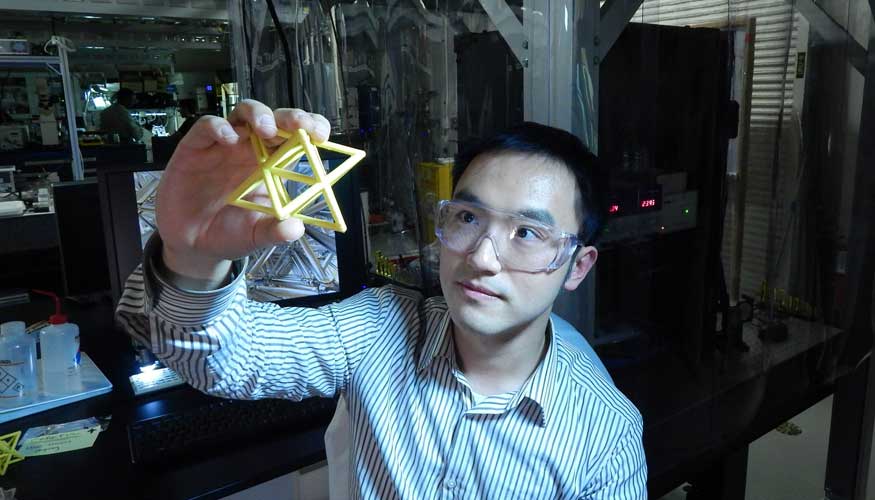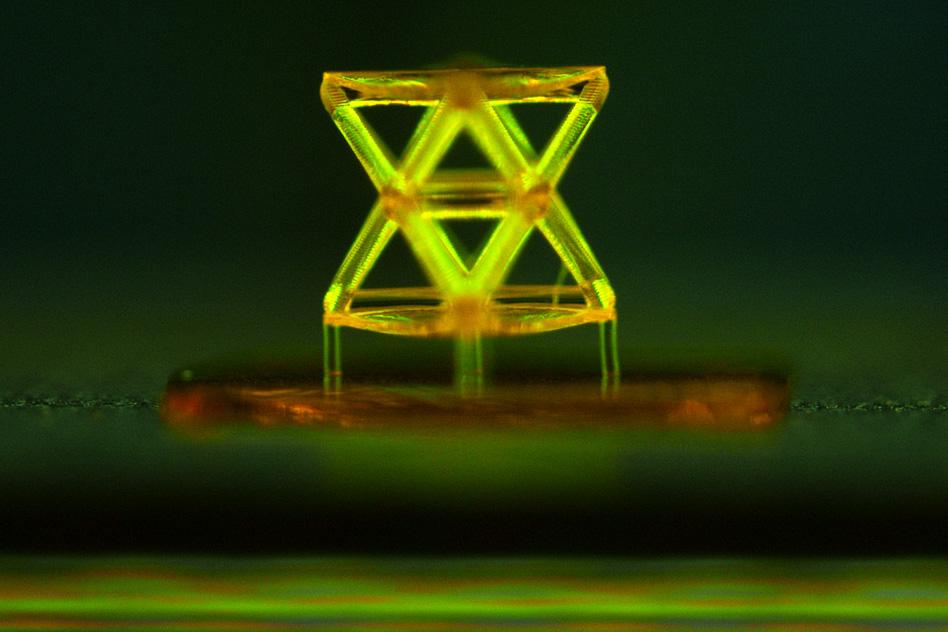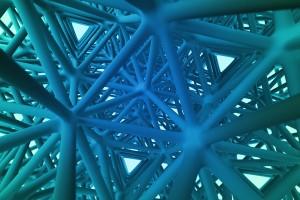Researchers Use Microstereolithography 3D Printers to Print Objects 400X’s Stronger Than Current Standards
When it comes to 3D printing, most people visualize the process on a macro scale, a scale which can be observed with the human eye. Critics of 3D printing argue that, in its current state, the technology is best used for prototypes. This is because we are limited by 2 factors: Material availability, and resolution of prints. Even though more and more materials are being introduced to 3D printing on an almost daily basis, we are still extremely limited when compared to traditional manufacturing techniques. Resolution of 3D printed items on todays machines range from poor, on consumer level FDM machines, to excellent, on industrial level stereolithographic and selective laser sintering machines. Still though, there can be great improvements made.

Left to right: LLNL research team members and co-authors Eric Duoss, Julie Jackson, Chris Spadaccini, Xiaoyu “Rayne” Zheng and Todd Weisgraber in the lab hold larger versions of the architected materials. – Source – LLNL
A group of researchers from MIT and Lawrence Livermore National Laboratory have come ou with a method of creating what is referred to as micro-architected metamaterials, by using an advanced form of 3D printing called microstereolithography, which work in the same basic way as today’s SLA 3D printers, but on a micro scale. It allows for extraordinary precision, in not only the 3D printing of an object, but the microstructure of that object as well.
If you were to take a microscope (at 25X) and examine common household items, under the right conditions, you would find that each material you examine looks different under a microsope than the next. This is because they are made up of all different densities due to the material differences. When a material is more dense, it is stronger. When it is less dense it will be weaker. Using this knowledge, the group of researchers set out to construct new metamaterials.

Lawrence Livermore Engineer Xiaoyu “Rayne” Zheng — lead author of the Science article — studies a macroscale version of the unit cell, which constitutes the ultralight, ultrastiff material. Photos by Julie Russell/ LLNL.
The research group included Howon Lee, an assistant professor at Rutgers University, Nicholas Fang and Qi “Kevin” Ge of MIT, as well as Christopher Spadaccini, Xiaoyu “Rayne” Zheng”, Todd Weisgraber, Maxim Shusteff, Joshua Deotte, Eric Duoss, Joshua Kuntz, Monika Biener, Julie Jackson, and Sergei Kucheyev of LLNL.. They took an idea that was developed decades ago, but until now was only a complicated mathematical equation and models on paper. By utilizing very precise microstereolithography 3D printers, they were able to develop and print incredibly unique and potentially world changing materials.
“We found that for a material as light and sparse as aerogel [a kind of glass foam], we see a mechanical stiffness that’s comparable to that of solid rubber, and 400 times stronger than a counterpart of similar density. Such samples can easily withstand a load of more than 160,000 times their own weight,” explained Nicholas Fang. “The key to this ultrahigh stiffness is that all the micro-structural elements in this material are designed to be over constrained and do not bend under applied load.”
On top of being 400 times stronger than similar materials of the same density, these materials were also 100 times stiffer than other ultra-lightweight lattice materials, previously reported. The researchers were able to arrange the structures of the material in ways that would make the final metamaterial extremely light weight, very strong, and very stiff. They have tested this printing method on ceramic, metal, polymer, as well as a polymer-ceramic hybrid, all showing the same benefits.
“This material is among the lightest in the world,” LLNL’s Spadaccini says. “However, because of its microarchitected layout, it performs with four orders of magnitude higher stiffness than unstructured materials, like aerogels, at a comparable density.”
This means that we are now able to, not only 3D print objects that look anyway we want them to, but we can also 3D print objects that take on different physical characteristics, making them stronger, stiffer, harder, etc. The potential uses for this type of 3D printing has unlimited potential.

This is a single unit of the structure, 3D printed from a polymer – Stretch-dominated octet truss unit cell
Some of these possibilities include batteries for mobile devices, bicycle frames, automobile parts, aerospace engineering, prosthetic limbs, and the list goes on. Other researchers believe that this technology will eventually be used to create materials that could be created as flat panels, and then assembled together in small unit cells, in order to make up the larger desired structures. There are also numerous uses for circuits, creating smaller, much more efficient electronics.
Without the use of these highly sophisticated 3D printers, development of these metamaterials and their complex 3D micro-scale geometries would be near impossible, to impossible. “Now we can print a stiff and resilient material using a desktop machine,” said Fang. “This allows us to rapidly make many sample pieces and see how they behave mechanically.”
What do you think? How soon do you think it will be before people will be uploading their own unique metamaterial designs to websites like Thingiverse for others to download and print on their microstereolithography 3D printers? Discuss in the 3D Microstereolithography Printer forum thread on 3DPB.com
Here is a video that shows a little more detail about the microstereolithography process.
Subscribe to Our Email Newsletter
Stay up-to-date on all the latest news from the 3D printing industry and receive information and offers from third party vendors.
Print Services
You May Also Like
Aussie 3D Printing OEM AML3D Expands into UK Defense Market via BAE Systems Deal
The Australian original equipment manufacturer (OEM) of wire additive manufacturing (WAM) systems, AML3D, has made expansion into the US defense market the cornerstone of its business strategy since pivoting a...
Daring AM: 3D Printed Guns Go From Homemade to Heavily Watched
As law enforcement intensifies its efforts and agencies roll out new regulations, 3D printed guns are becoming a bigger part of the ghost gun conversation. In March 2025, the U.S....
Conflux 3D Prints Cooling System for Australia’s Zero-Emission Hydrogen Aircraft
In a major step toward zero-emissions aviation, Australian aircraft manufacturer AMSL Aero is developing one of the most ambitious electric aircraft in the world: Vertiia, a hydrogen-powered vertical takeoff and...
BellaSeno’s 3D Printed Breast Implants Keep Shape with 87% Fat Volume, Avoids Silicone Risks
At a medical conference in Austin this week, a new kind of breast implant took center stage. It is not made from silicone but from a 3D printed, fully resorbable...


























